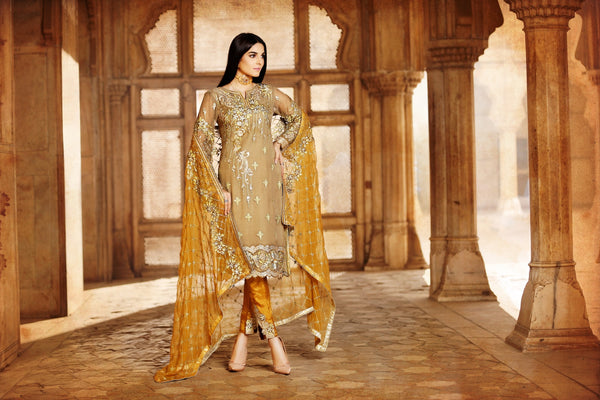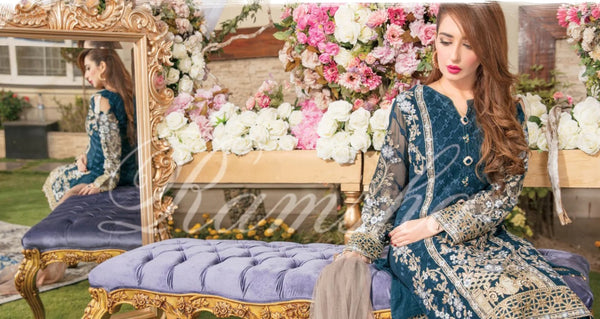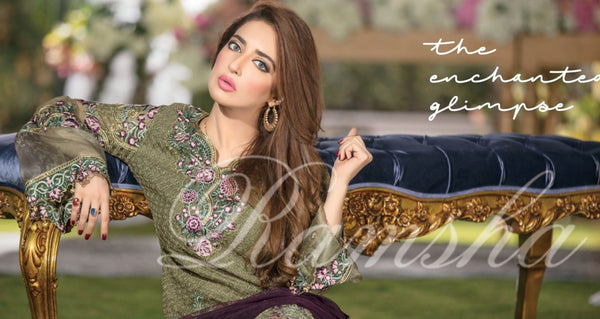What is a Salwar Kameez?
Salwar Kameez is a traditional outfit originating in the Indian subcontinent. It is a generic term used to describe different styles of dresses.
The salwar (trousers) and the kameez (shirt) are two garments which are combined to form the salwar kameez. They are often worn with a third piece of garment called a dupatta.
It is the national dress of Pakistan, and commonly worn throughout the Indian subcontinent which includes India, Pakistan, and Bangladesh.
Salwar Kameez have a huge variation in design and style of stitching based on their origin.
This dress is basically a three-piece combo of a long shirt paired with loose trousers. Women also pair it with a dupatta scarf that could either be draped across the shoulder or cover the head.

Red Salwar Kameez Design for Women
It’s one of those ethnic dresses that hardly needs an introduction.
Salwar Kameez Background/History/Origin
The Salwar Kameez is a highly beloved dress - one of those few types of ethnic dresses you’re more likely to see in most Indian women’s wardrobes. In Pakistan, the dress is also so much loved to the extent that it has been made the national dress of the country. How did the salwar kameez become such a fashion staple for all? It began sometime around the 13th century.
The salwar kameez traces its origin to the legendary Mughal Empire era of India. Around the 13th century, the Muslims first arrived in South Asia. The dress was introduced into South Asia by the Mughals. Soon after, it became the traditional dress of the historical Punjabi region. From there, the salwar kameez spread far and wide from being a regional dress to the international dress it is today.
But the Salwar Kameez story is not limited to South Asia. The salwar kameez was also introduced to Singapore after World War II when more women from India migrated to Singapore, increasing the population of the country’s Indian community. From here, the dress became more popular among the Punjabi women and eventually grew to be loved by even women of other ethnicities.

Designer Salwar Kameez for Women
Also known as the Punjabi suit, the salwar kameez has undergone several evolutions over time. Today’s variations tend to be sleeveless and often more tight-fitting compared to the conventional salwar kameez dress. Everything from the width of the trouser cuffs to the length of the kameez top has seen (and continues) to see certain changes.
The Making Of A Salwar Kameez (Process, Fabric, etc)
Simplicity, versatility, and affordability are some of the key things that have endeared the Salwar Kameez to women the world over. Talking of versatility, you can get your salwar kameez made in almost any type of fabric from silk to cotton, georgette, chiffon, velvet, and what have you ( the classic material for the salwar kameez is cotton. For many centuries, the salwar was mostly made using the cotton fabric).
Similarly, you can choose to have diverse kinds of embroidery or print work on your dress, whatever catches your fancy! In making a salwar kameez, the general dress style usually is a long and straight silhouette with two side slits. The dress usually extends below the knee length with the chunni or dupatta always spotting a rectangularly-shaped style.
Different kinds of salwar kameez usually sport different kinds of designs.
Two of these prominent designs include the Patiala suit and the Anarkali suit. The Patiala suit can be traced to the Patiala region of Punjab, a place whose tradition, arts, and crafts are highly developed. Patiala salwar suits are designed to include a knee-length kameez paired with a baggy salwar. The salwar is designed to be more voluminous than average while the chunni is also designed to be much longer than others.
Anarkali suits, on the other hand, sport a slightly different style.

An Indian Salwar Kameez Style
The dress, whose origin goes directly back to the Mughal era has a characteristically long kurta that could either be as long as around the ankles or even as floor-length anarkalis, in some cases. The Anarkali suit design is usually designed to look like this long flowy skirt with a tight bodice that flares out around the waistline. Unlike most other salwar kameezes that are often worn for casual outings and everyday use, the Anarkali is commonly worn on special occasions because of its regal and highly sophisticated appearance.
The Most Popular Salwar Kameez Styles & Types
There are different variations of salwar kameez which can serve different purposes and occasions. Here are some of the most beautiful and stylish ones you might want to get for yourself anytime soon;
- Anarkali Style Salwar Suits: this salwar suit style includes a long frock-style top that usually extends to the ankle or floor along with a slim-fitted bottom. The top consists of a fitted bodice upper area that then flares out at the waistline to look like a circular skirt. These may or may not have slits and are perfect for weddings and formal events.
- Cigarette Salwar Suits: this salwar style usually features slit kameez tops that extend to the knee paired with tight-fitting cigarette pants.
- Patiala Suits: this includes a knee-length kameez top paired with baggy salwars with loose layers that create an illusion of a fuller shape of the lower section.
- Palazzo Suits: best-suited for tall and average height girls, the main differentiating factor in this design is the loose palazzo pants paired with the salwar top. Palazzo suits have this casual and more relaxed vibe.
- Salwar Kameez Kurta: Short kurtas paired with modern-looking pants can be stylish and are popular among girls who want something that looks simple and more modern. The kurtas can be paired with dhoti or Patiala as the case may be.
- Slit Salwar Suits: this type of salwar suits have their slits in the front rather than on the sides. They can help make a woman appear taller and are most suitable for women of average and tall heights.
- Conventional Salwar Suits: women of all heights, sizes, and shapes are bound to look awesome in a conventional salwar suit. Some of these include salwars with a broad lower part that is usually tapered at the base, paired with a kameez that stops below or around the knee length.

Salwar Suit with Embroidery Work
The Hottest Salwar Kameez Trends Right Now
Are you eyeing salwar suits and would like to add one or more salwar kameez dresses to your wardrobe? If so, here are some of the trendiest salwar suits currently in vogue;
- Sharara salwar suits: the sharara salwar usually flares out at the waist to the bottom. More of these salwar dresses have been dominating the scene recently, sporting beautiful embellishments from zari to stones, sequins, etc.
- Bandghala for women: think bandhgala is exclusively for men? Think again! Bandghala for women are having a great time in Bollywood and they’re a great sight to behold in their different prints and patterns.
- Pre Attached jackets/dupatta: don’t know how to style a dupatta? You can grab one of these new salwar suits pre-attached with dupattas, and even jackets, in some cases.
- Gota Patti and Patra: in recent times, we are beginning to see more Anarkali suits sporting gota Patti and Patra embroidery and they’re beautiful to look at!
- Cropped salwar pants: from crop tops to crop pants, the fashion scene continues to evolve at an incredibly fast pace. You’re sure to like many of these new salwar suits with their unconventional crop salwar pants that gives salwar suits and their wearers a kind of rich and sophisticated look.
- Ankle-length Anarkali: Anarkali suits that stop just around the ankle are coming out in diverse styles and designs. Pair these with matching churidars, palazzo, and a dupatta and you’re sure to look effortlessly chic.
- Unconventional sleeves: from bell sleeves to floor-length Anarkali with cape sleeves, churidar sleeves, hem cloud, tassels, and more are redefining salwar suits and their sleeves, different from what we’ve always known.

A Typical Pakistani Style Shalwar Kameez
How/When To Wear A Salwar Kameez
The good thing about salwar kameez is that they’re very easy to wear and there’s always a salwar suit for almost every occasion from weddings to casual outings, funerals, parties, etc.
While salwar kameez dresses are common among women and young ladies, more women today see the salwar kameez as a traditional outfit that kind of suits their lifestyle needs, in a slightly different way to the saree. And unlike the saree, the salwar kameez is much easier to wear and you’ll hardly have to worry about learning how to wrap or drape it.
What Makes Them Popular/Loved
There are probably a million and one reasons to love the salwar kameez. From the simplicity of the outfit to the ease at which it can be worn, the list is virtually endless.
Salwar kameez makes it easy to move around freely and this is why it can easily be worn as a workplace dress for working-class women.

Anrkali Style Salwar Kameez for Women
And while there are simple and casual styles you can don on for everyday use, there are also some highly functional and super stylish salwar kameez that will easily help you turn heads at special occasions and formal events. The salwar kameez is loved for its sheer simplicity, ease, and comfort, beauty, and functionality. What else can one ask for in a dress?






